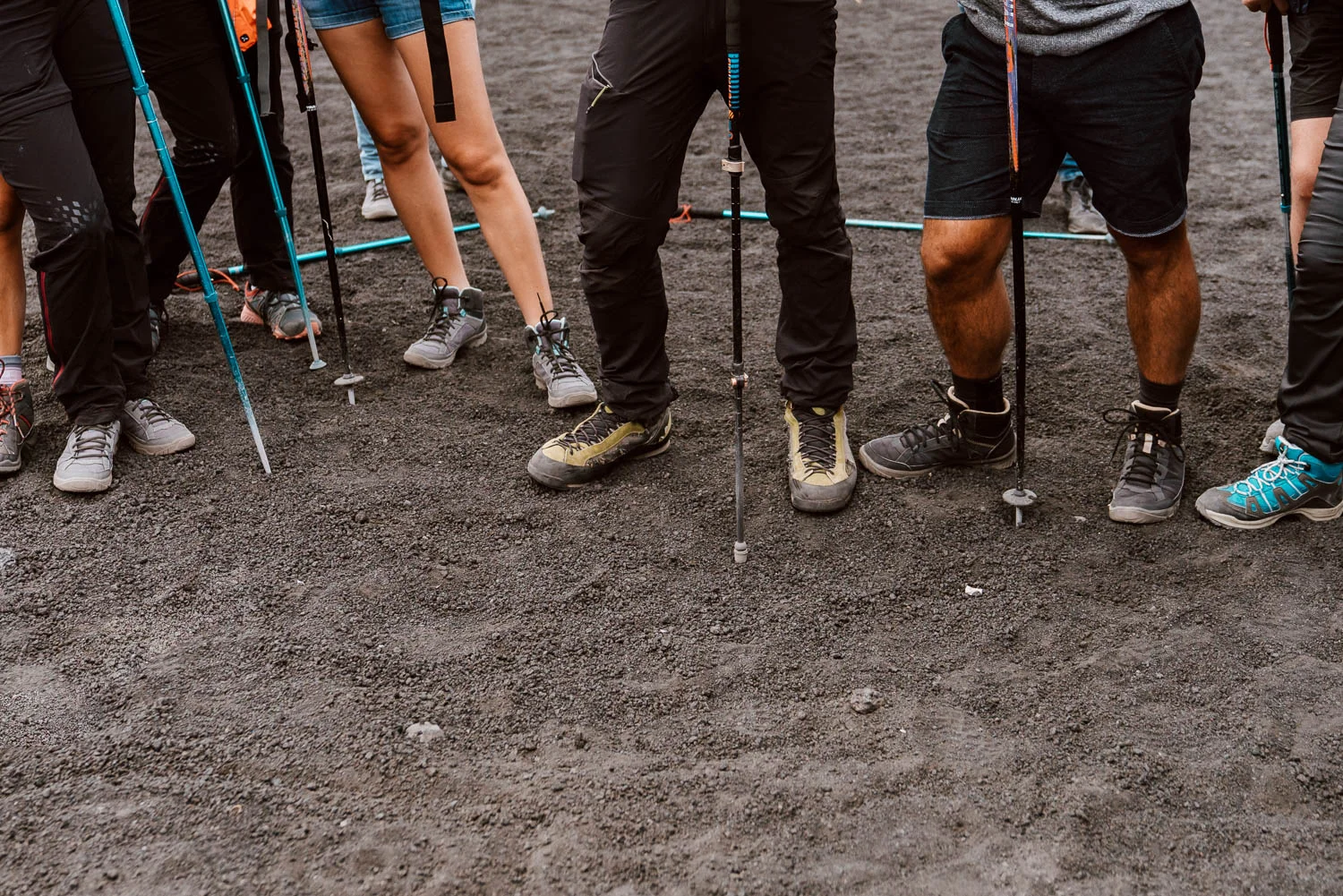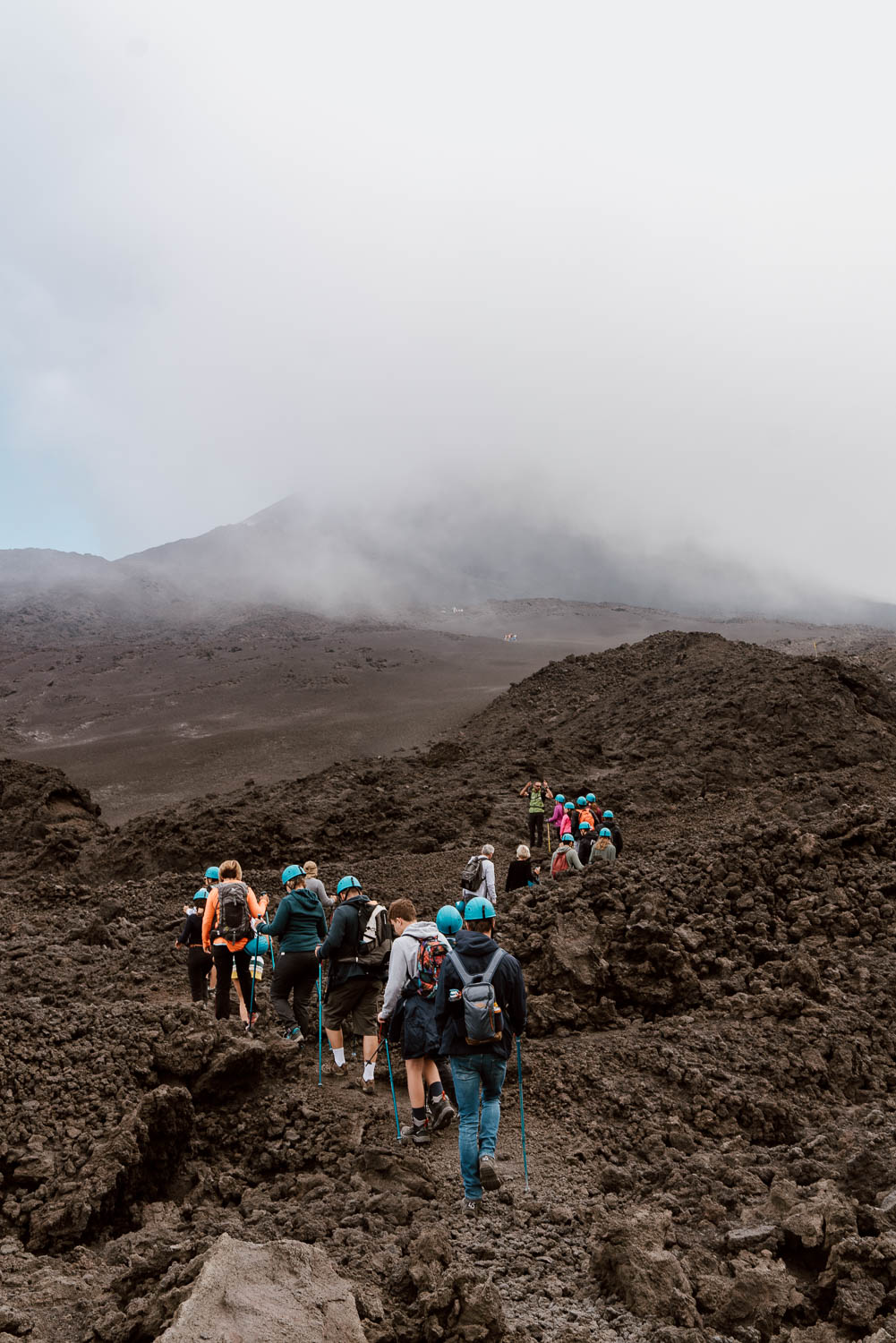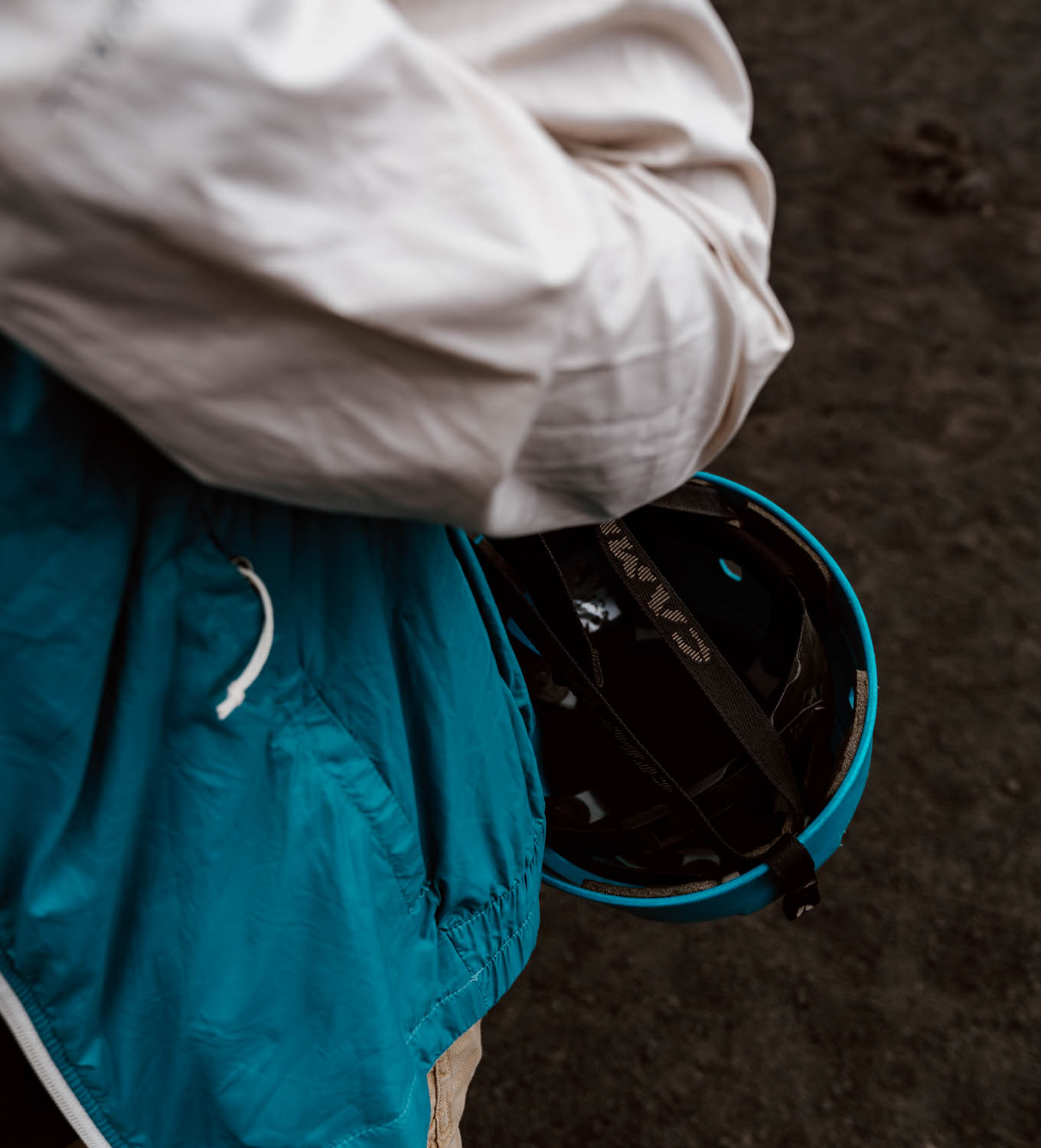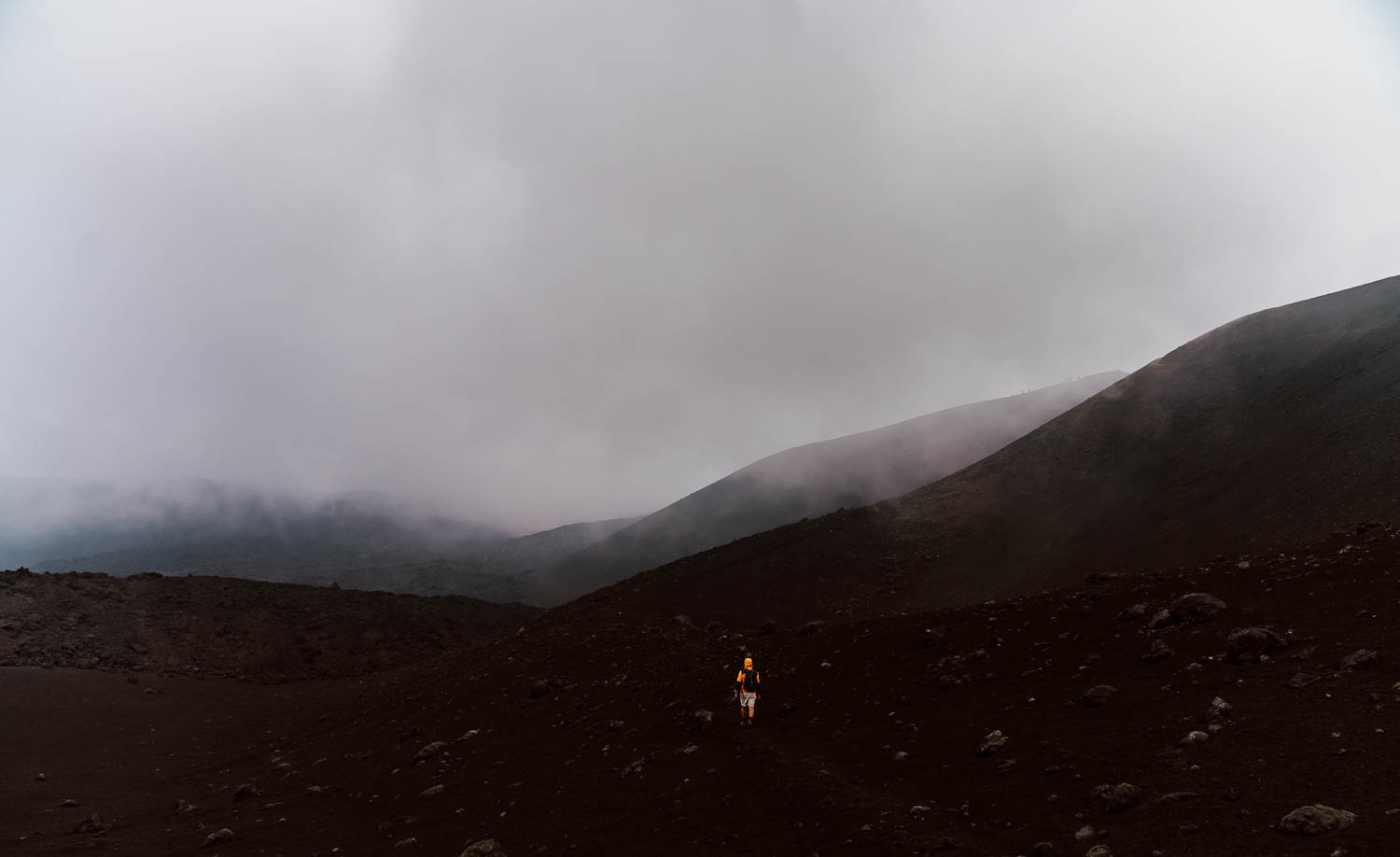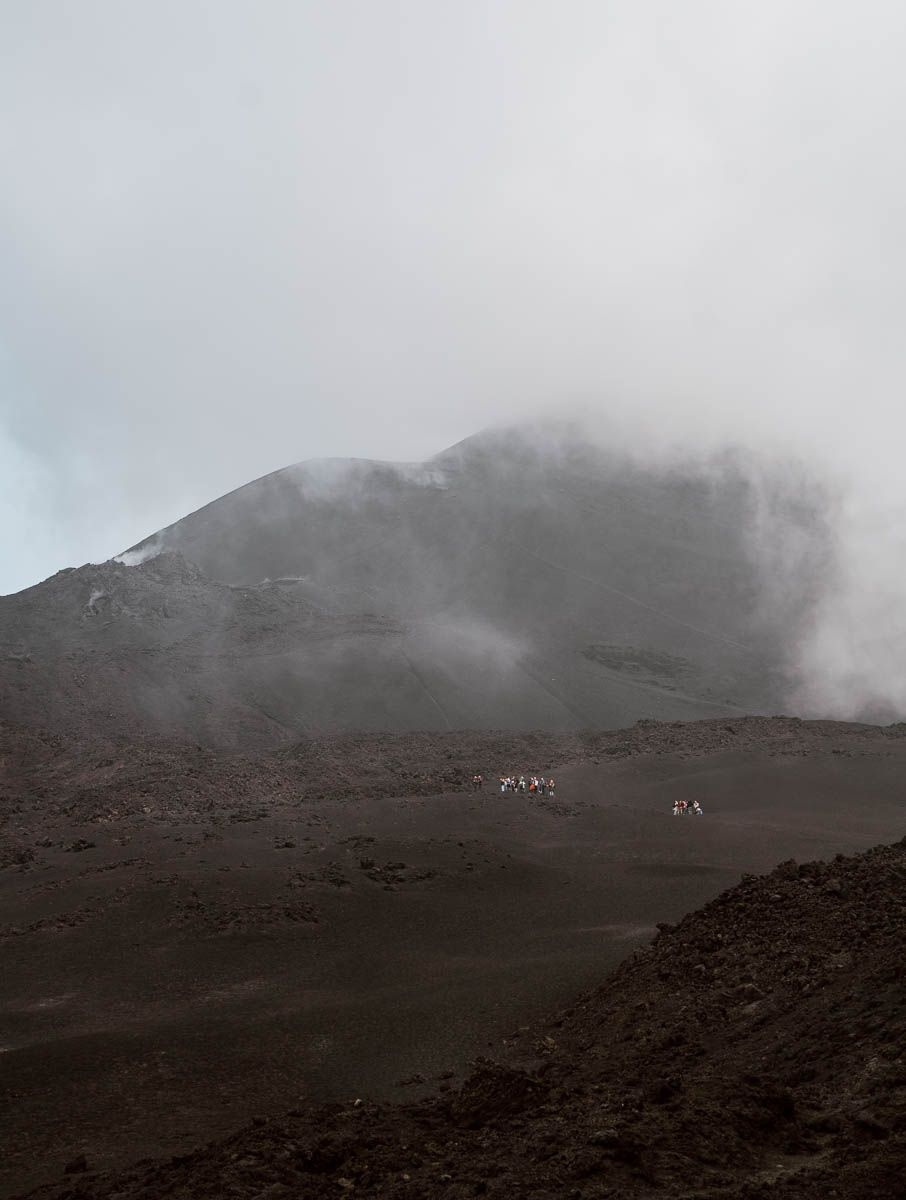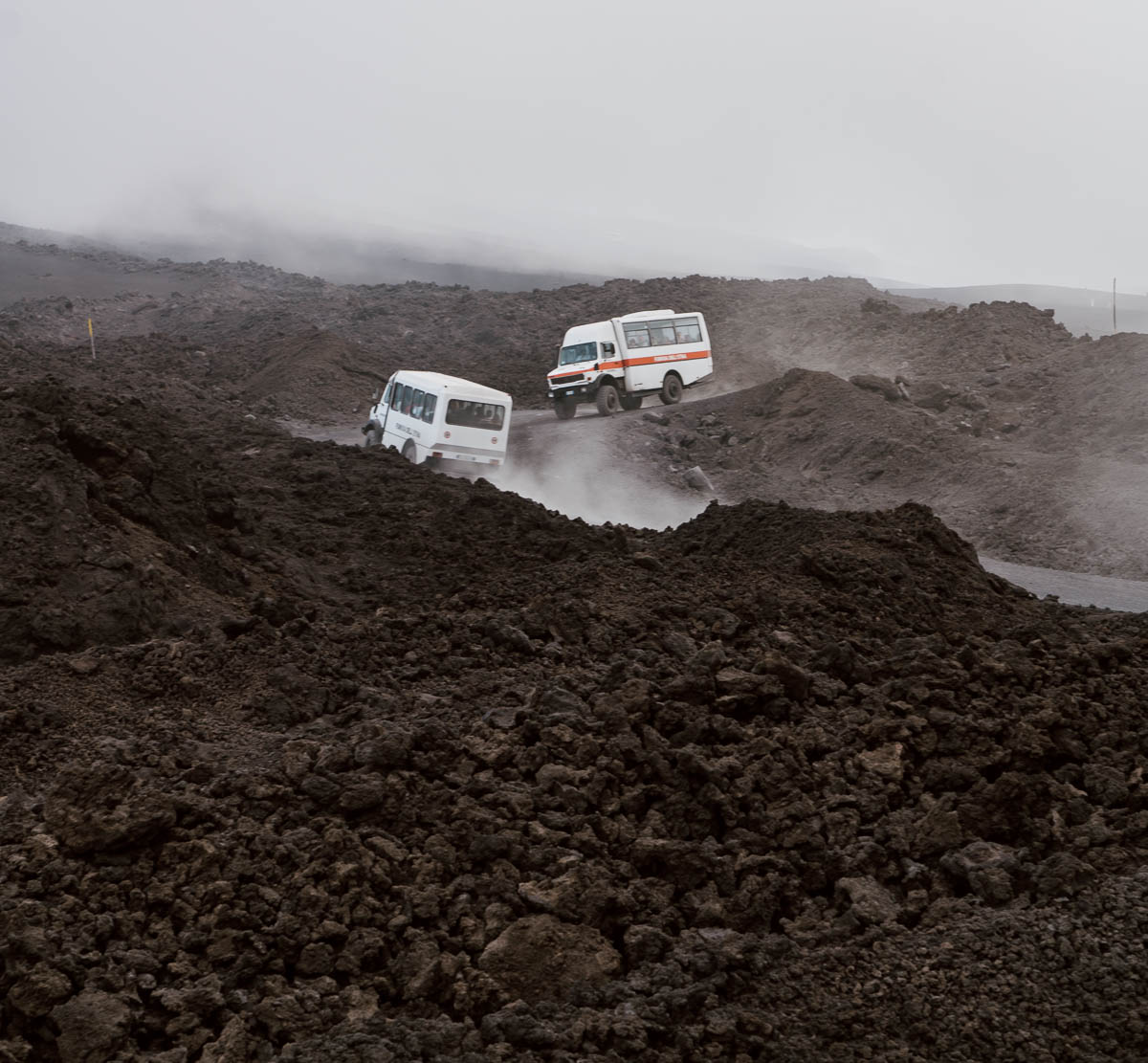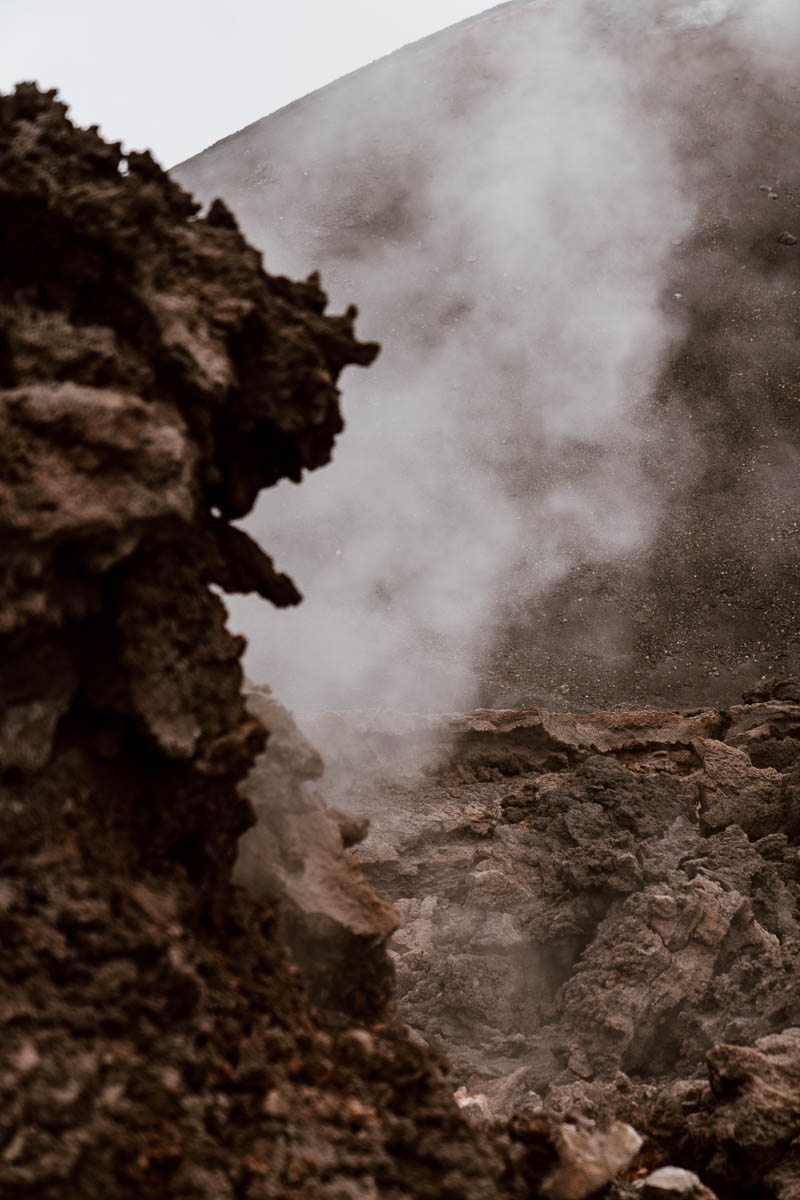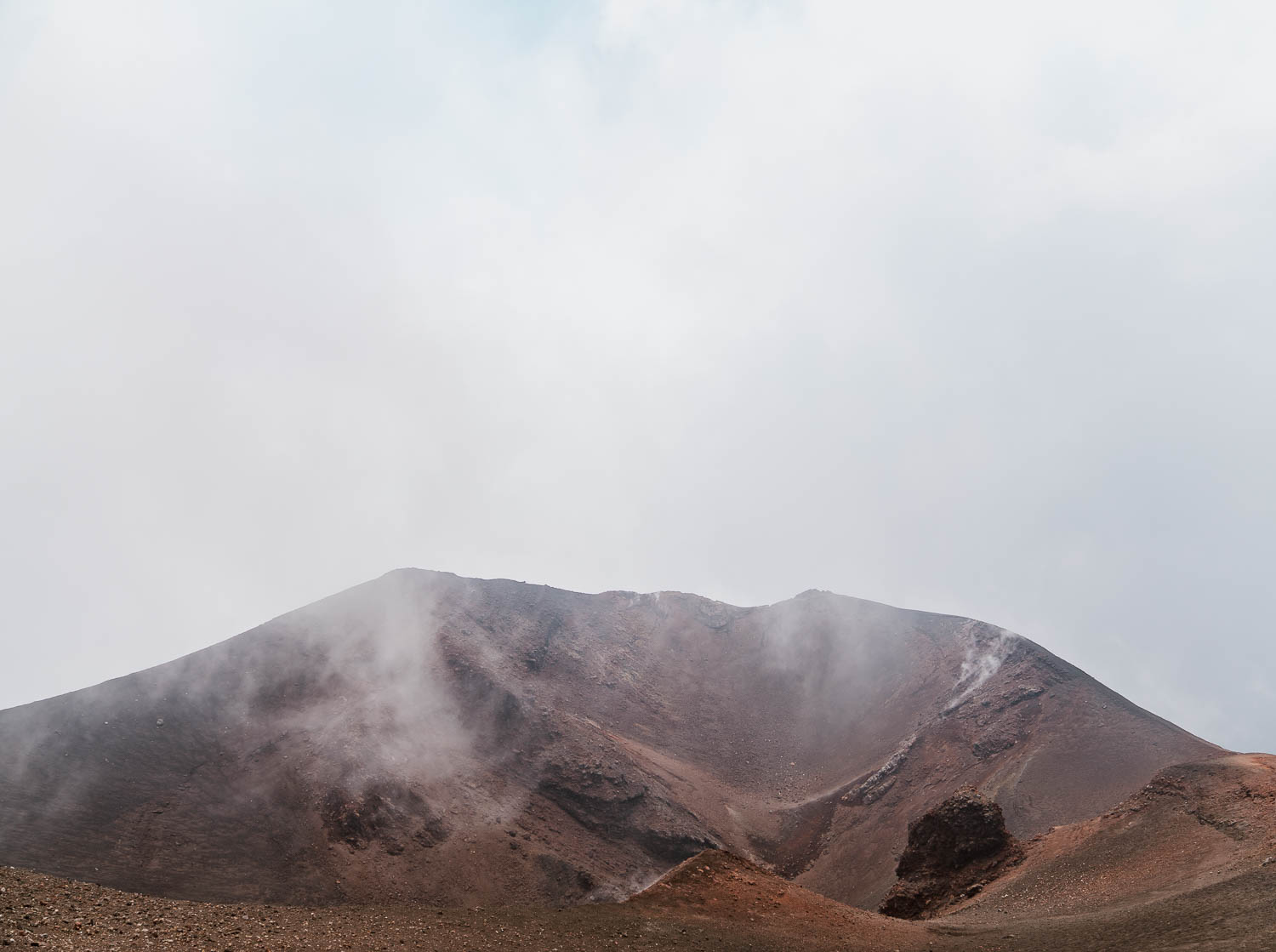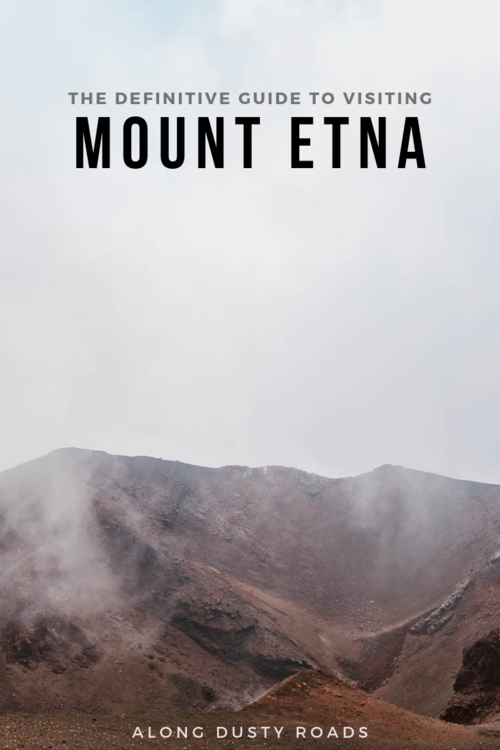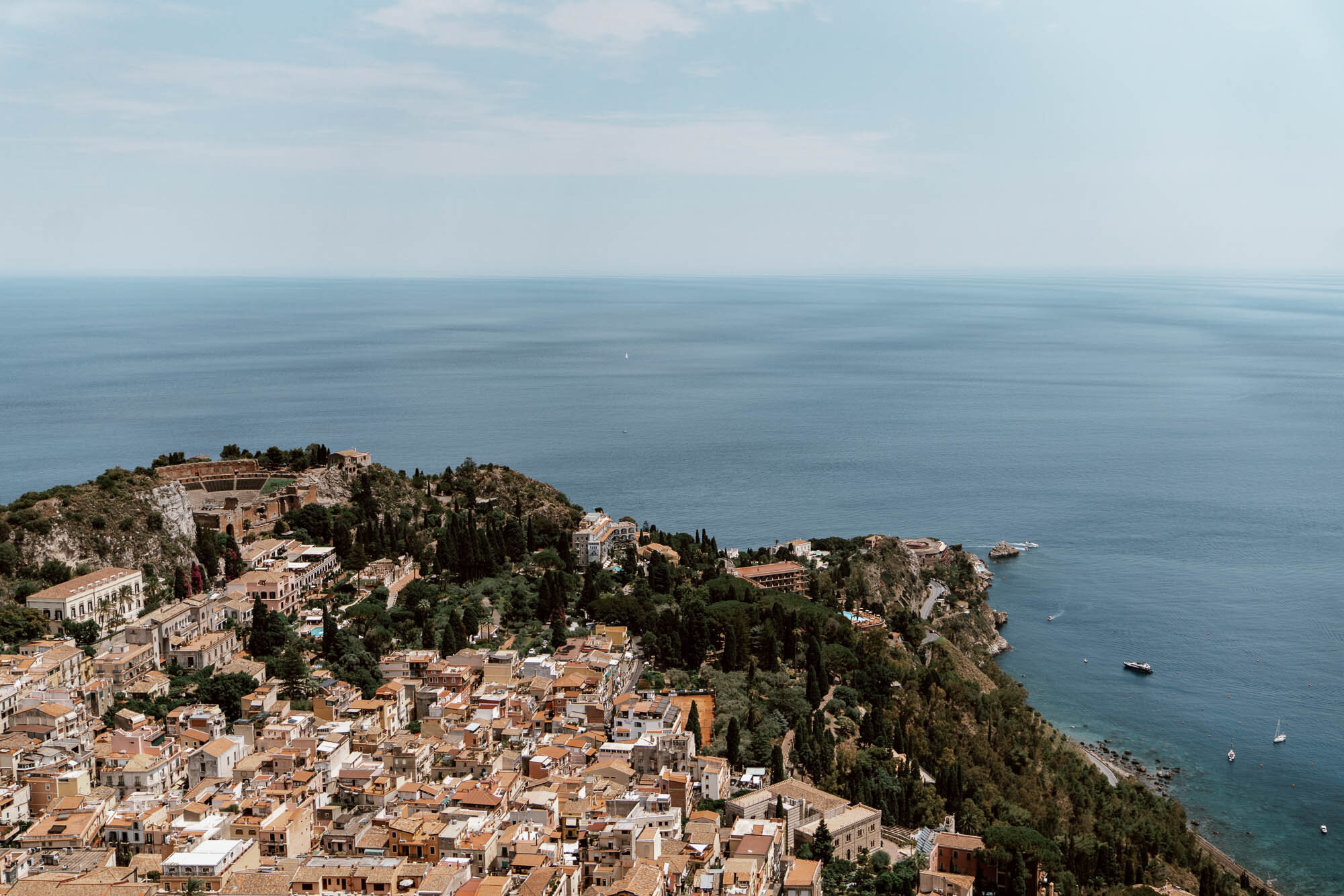Year 8 geography class. That’s where I first heard about Mount Etna, Europe’s most active volcano.
Fast forward many (seriously, too many years), and whilst I had camped atop volcanoes in Guatemala, boarded down one in Nicaragua, and hiked several in Ecuador, Etna was still a pencil-drawing in a 12 year old girl’s workbook; a quasi-mystic location that didn’t really feel like it should exist in Western Europe.
Indeed, the captured footage from relatively recent eruptions calls to mind that which one would find in the aptly named ‘Ring of Fire’ much further east, or from a Europe that existed long ago - not in a popular Italian tourist destination. Perhaps it is this 'other-worldliness that so excites and enthrals those that visit this mediterranean island - Etna’s perpetual state of absolute activity that means a night sky illuminated with shooting fire is more than just a passing possibility.
And so, eruption or no, when we made the decision to spend a month traversing the coast of Sicily this summer, I was determined to take on Europe’s beast; to climb Etna.
In this guide, you will find all the really important information and advice you need to know before visiting Mount Etna - whether you want to climb the summit with a tour, hike Mount Etna on your own, or just enjoy it from a safe distance. It also includes our personal tips on what to bring, how best to get to the site with public transport (if you aren’t on a Sicily road trip), plus useful insights on hidden costs and tours to avoid.
This is everything you really need to know before you visit Mount Etna!
Mount etna | The Basics
On the east coast of Sicily, Mount Etna is Europe’s most active volcano and a UNESCO World Heritage site - it’s also a popular traveller attraction.
All roads lead to Rifugio Sapienza, or ‘Etna South’, where there is a visitor centre and car park.
Mount Etna can be fully explored year-round with a tour or you can visit certain areas independently.
Summit tours are the most popular option. They start at 9 a.m., last for around six hours, and cost €35-50 per person + transport; we did this tour.
Etna is at high altitude (over 2,500 metres above sea-level), and you need appropriate clothing and footwear - it’s an easy hike but not something for your flip-flops and beachwear.
Pick your base carefully
Visiting Mount Etna by car is easy, and you could feasibly choose a base anywhere along the coast and drive to Mount Etna early in the morning. However, your most likely departure points if going with your rental car are Catania or Taormina. Both are popular bases for people holidaying in Sicily, as well as stops on an east Sicily itinerary, and are about an hour’s drive to the Etna entrance.
However, you need bear in mind that the roads leading to Etna are very windy and impossible to travel at speed. We were based in Aci Trezza, just outside Catania, and what looked like a relatively short distance on the map turned into a much longer travel time than expected, requiring a bit of a rush towards the end.
Those relying on public transport or taking a tour to the volcano should ideally opt for Catania (we’ve included more information on the public transport connections later in the article).
Tip | If you’d like to stay much closer to the volcano for a night, you can find accommodation options here.
Mount Etna is at Altitude…
Mount Etna’s summit is at 3,300m, and Torre Del Filosofo (from where you will begin a summit hike) is at 2,900m; both of these are heights at which you could feel the effects of altitude sickness.
Given that you will be likely holidaying in Sicily, a place that is almost exclusively at sea level, there’s not much you can do about acclimatising to the altitude, so you’ll need to just pay attention to your body. It’s totally normal for you to get a little bit more out of puff on this hike due to the thinning air, but should you begin to feel unwell, you absolutely need to stop, tell you guide, and consider turning back - the very best cure for altitude sickness is getting below 2,500m.
If you’d like to read more about this altitude sickness, head over to this post.
…Which means it’s also pretty damn chilly!
We know it’s difficult to imagine your Sicilian summer holiday involving anything but dips in the ocean, Aperol spritz, and bright blue skies, but the altitude of Mount Etna means that even in the summer months it gets quite cold at the top.
We visited during July and, dressing in our ocean view Airbnb first thing in the morning, donned a pair of shorts each. We stoically marched around bare-legged for the duration of our Etna day trip but in all honesty, would have been much happier in a pair of hiking leggings. Similarly, we started out in a vest/t-shirt but by lunch time had chucked on the emergency fleece and the hoods of our windbreakers remained pulled over our heads.
So yeah, do not underestimate how much the temperature will drop as you explore Etna - and if you’re visiting outside of summer, bear in mind that you will absolutely need proper winter hiking gear.
Tip | Whilst you will need to provide most clothing yourself, it is possible to rent thick jackets from the Mount Etna cable car station for 4 EUR - this means you don’t have to worry about taking up valuable space and weight in your suitcase with a jacket that will be redundant for 98% of your time in Sicily.
We have more advice on a what to pack for a Mount Etna day trip at the end of this post.
Active volcanoes are sometimes, well, active
Part of the excitement of visiting Mount Etna is the opportunity to come face-to-face with an incredibly active volcano. The problem with this is the risk that on the day you choose to climb it, it’s a little too active.
As happened to us.
We were understandably a little upset when upon meeting our tour guide at 9 a.m., we were advised that it wasn’t safe to venture beyond 3000m that day due to increased activity. It was, undeniably, the absolute right decision though - especially when Etna’s main crater had a full on eruption and began spewing molten lava high into the air later that night and meant that airports had to close for 24 hours!
Seriously. Take a look at footage here.
If this should happen to you, be assured that the tour will be adapted so that you can still safely explore and enjoy Etna. In our case, we took an alternative route to Torre Del Filosofo (at 2,900m) that allowed us to enjoy some of the older craters as well as walk through impressive lava tube. All explored with a background rumble of an excitable Etna, which was quite the experience!
Lastly, given the likelihood of activity, be aware that all tours and visits may be cancelled if safety risks are too high. In decades past, the visitor centre and cable cars have been destroyed by Etna eruptions, so any warnings have to be taken very seriously.
If you want to see the summit, you need a tour
Long time readers of Along Dusty Roads will know that the very first thing we do before we embark on a new day time adventure is establish whether it’s something we can do independently.
With Etna, the answer isn’t completely clean cut: you can safely get up to 2,900m by yourself (we’ll go through these options a little later), but if you want to see the summit then you to go as part of an organised tour led by a qualified guide who is very familiar with the route, carries safety equipment (including a radio), and can orientate themselves to and from the summit in bad weather.
This rule was first brought in in 2013 and, though it may seem a little frustrating, you simply have to consider the fear amongst the Sicilian tourism board of someone accidentally tumbling into the crater of an active volcano before realising the tour guide requirement makes complete and utter sense.
Thankfully, there are a number of Mount Etna tour options. After a lot of research, we went with this one and were really happy with the company and guide. We were also able to book it easily online the night before we wanted to visit Etna. Plus, at 35 EUR each, it was significantly cheaper than we expected!
Most tours meet in the Mount Etna visitor centre car park at Rifugio Sapienza, and the tour price includes the guide and equipment rental (helmet, hiking boots, and walking pole) but does not include a hotel pick-up (you will need to make your own way to the Rifugio) or the Mount Etna cable car and 4x4 bus that you will be required to take to get to the hike start point (we explain this transport further in a later section). Summit crater tours last around 6 hours.
But it’s not the only tour option!
If you don’t want to conquer the summit, but you’d still prefer to go on an organised Etna tour it’s worth knowing that there are a few alternative options:
Mount Etna Sunset Tour | As photographers, this was the one that we were tempted by. Gorgeous light and the chance to see Etna’s lava glow red in the darkness? Yes please. This tour comes very highly rated.
Mount Etna Day Tour with Limited Hiking | Ideal for those that would prefer the convenience of pick-up from their hotel or don’t fancy a lot of hiking, this tour departs from Catania and is suitable for everyone from young families to older people. There’s also this one with hotel pick-up from Taormina.
Helicopter Ride over Etna | Before you click on this link, we want to acknowledge that this is so, so very expensive (and completely unrealistic for most people - including us) but after taking a look at this drone footage, all we can think is how amazing it much be to see it from this vantage point! Find out more here.
You can find a more comprehensive list of Mount Etna tours here.
There are three ways to get to Rifugio Sapienza
Unless you have a tour that includes hotel pick up (like this one from Catania), everyone will need to make their own way to Rifugio Sapienza, otherwise known as ‘Etna South’.
This is the highest point that you can drive to, it’s where the Mount Etna cable car leaves from, and where all the tourist facilities are - unsurprisingly, it’s much busier than the alternative ‘Etna North’.
You can easily reach the rifugio by hire car (as we did) or by public bus from Catania. Do note however that, departing from Catania’s Stazione Centrale (the main railway station), there is only one direct bus per day, at 8.15 a.m. In peak summer season this becomes an incredibly popular option and so it is essential to book and pay for your ticket as early as possible - ideally the day before. This can be purchased from the AST office near to the train station. Frustratingly, the bus also stops at a small town called Nicolosi for half an hour en-route, meaning you don’t arrive at Sapienza until 10.15 a.m., by which time summit tours have already started. This means that taking public transport is really only a realistic option if you want to explore Mount Etna independently.
The bus back to Catania leaves at 4.30 p.m. and if you want a good seat, be sure to get there nice and early.
Note that there is plenty of parking at Rifugio Sapienza, which, although technically free (or at least according to a number of people and our experience), you may need to pay ‘a guy’ 1 EUR to look after your car.
Planning on road trip? Make sure you check out our east Sicily road trip route and our essential tips for driving in Sicily.
There’s a transport network almost to the top (but it’s expensive)
If you’ve been doing any other research about visiting Mount Etna, you’ll probably have heard mention of a cable car?
Whilst it’s absolutely possible to hike all the way up to 2,900m without paying for any additional transport options from the visitor centre car park, the vast majority of people choose to take a cable car from Rifugio Sapienza to a Mountain Hut (which also doubles as a cafeteria), and then a 4x4 bus to Torre Del Filosofo, from where the summit hike begins.
The first Mount Etna cable car departs at 9 a.m., taking around 10 minutes to make its way slowly up, and then leaves every 15 minutes thereafter. During peak season (June - August), the queues are pretty darn long so be prepared to arrive early if you’re on a tight schedule. When you purchase the ticket, you’ll be given a re-usable plastic ticket which you will need to swipe to access the funicular (and remember to keep it for the return leg!). The price is 30 EUR return, per person.
And yes, we thought that this was quite a lot of money too! When asking our guide, he reminded us that one of the downfalls of having a cable car station atop Europe’s most active volcano is that said volcano has a dreadful tendency to erupt with relative frequency and destroy everything in its path. Unsurprisingly, there have been several necessary reincarnations of the cable car over the years, and we imagine insurance premiums are a nightmare.
You will exit the cable car at the Mountain Hut (which has toilets, a small cafe, and jacket rental) and then have the choice of either hiking up to Torre Del Filosofo, or jumping on one of the 4x4 jeeps that we’ve mentioned previously. In all honesty, unless you’re in pretty poor health, we’d recommend just stretching your legs. The jeeps are pretty darn pricey for what they are (30 EUR return) and it’s a relatively easy and enjoyable 40 minute hike - just follow the buses.
If you choose to do the combined cable car AND jeep, it’s best to buy a combo ticket for 57 EUR.
It’s important to note that if you choose to do the summit climb as part of a tour, you will have no choice but to take both the cable car AND the 4x4 bus (to save time), and this additional cost is never covered or included in the upfront tour price. Instead, each tour participant has to pay an additional 50 EUR per person to the tour guide in cash upon arrival. The guide will then purchase the whole group’s tickets in one-go, saving everyone time. This additional cost for the cable car and 4x4 bus is applied separately by every single tour company doing the summit walk! When researching Mount Etna day trip tour companies online, we discovered in the small print that several companies listed the additional transport costs as €65 rather than €50, so make sure not to book with them.
So, for complete clarity, when planning your Mount Etna budget you have to factor in the upfront cost of the tour + €50 for the cable car and 4x4 bus up the side of the volcano to the summit start point.
Yes, you can do the mount etna hike independently
If one of the above mentioned tour options doesn’t suit you or your budget, you’ll be pleased to know that it’s still completely feasible to visit Mount Etna without a tour.
If you’re on a strict budget, you can avoid the expensive cable car by hiking up to the Mountain Hut from Rifugio Sapienza. The wide path is very easy to locate, and the hike should take around 1.5 hours. Do note however, that it’s really not a terribly interesting walk across the volcanic gravel (and given its incline, this would be pretty hard going on a warm day), so do consider just how much you need to save the pennies before opting for it.
If you’re happy to pay for the Mount Etna cable car however, we’d recommend jumping out at the Mountain Hut and following the road that the buses take. After around 10 minutes, you’ll pass what appears to be another small volcano on your right - this is actually a now dormant, and completely imploded crater from an earlier eruption. You can follow the obvious path up and walk along a part of the crater rim.
Continuing on along the make-shift road, you will pass a variety of lava fields, arriving at Torre del Filosofo around 30 minutes later. At this point, you are able to walk around the entire circumference of large (very impressive) crater from the 2003 eruption. It’s not a difficult hike exertion wise, but the path is pretty narrow and there’s a couple of spots where you need to be careful not to topple over the edge - especially if you’re distracted by cool photo ops!
When you’re done, simply head back the way you came, and on to the cable car.
Please remember that, if you plan to hike Mount Etna without a guide, you are not allowed to go past 2,900m and attempt the summit walk - and it would be foolish to do so.
Different season. entirely different Etna
Whilst you can technically climb Etna all year round, having now discussed the altitude issue, you can surely imagine that the experience can be dramatically different dependent upon when you choose to visit. Here are the key points to note:
Winter (November - March) | Etna during the winter is, unsurprisingly, covered in snow. And whilst remaining open to visitors, it does require special equipment to climb safely. It’s for this reason that it’s advised to only visit as part of a tour which will be able to provide everything you need. The cable car and buses run throughout the year but do note that it’s not uncommon for bad weather to cause it to close temporarily.
Spring (April & May) | Considered the beginning of the tourist season in Sicily, this is when the weather warms up. There will still be snow on the ground (indeed, in recent years new snowfall has arrived as late as May) and you’ll definitely need to wrap up for your walk, but there will be very few tourists about.
Summer (June - August) | Peak tourist season on the island means long queues for the cable car and multiple tour groups trudging their way up to the summit. On the plus side, the snow has gone and the weather is at its best. Note that we visited Etna in July and, even though it was notably busy, it didn’t detract from our experience of the hike. It was chillier and windier than expected though, so dressing appropriately is still important.
Autumn (September & October) | Shoulder season at its best; the weather is still warm but the crowds have thinned out significantly. It is a little windier up top so don’t forget the jacket, and definitely opt for trousers over shorts.
The Food Options
For any day tour, you’ll need to bring some lunch with you.
We chose to bring leftover pizza in collapsible Tupperware to enjoy on our hike, but if you’re not quite as well organised do not fear; there is an excellent (seriously, it’s pretty damn impressive what you can buy half way up a volcano in Italy) selection of sandwiches and snacks available at the cafeteria in the Mountain Hut, as well as cold drinks and coffee.
You’ll need plenty of water too, and we carry these refillable water bottles to minimise our plastic usage when we travel. The staff in the cafeteria will happily fill them up on your way back down too.
Be A Responsible Tourist
It should go without saying, but please do remember that visiting Etna means visiting a place that could potentially be dangerous if you’re not sensible, don’t take precautions, or choose to breaks rules put in place to protect you. It’s also a UNESCO World Heritage Site, and place of huge scientific interest, and it is a privilege that all of us are able to explore it. Here’s some advice:
Stick to the paths | As you may imagine, the landscape of Etna is constantly evolving, and guides regularly have to create paths for visitors to use. They are intended to be stuck to! There is a very obvious path that should be followed unless joining a tour, and detouring away from it is strictly prohibited. Whilst you may not get told off (for some reason our guide chose to chastise only a handful hiking where they shouldn’t), if something should happen, you will only have yourself to blame!
Additionally, and we know we’ve already mentioned this, under no circumstance should you attempt to visit the summit without a tour. There is a very clear sign that signals at which point you cannot go any further - respect it.
Dress appropriately | Guides are full of stories, like that one with the Bangladeshi family he found in the middle of a lava field wearing flip-flops during thick fog, asking which way to the summit…Flip-flops are really not appropriate for this hike.
Weather | We’ve mentioned earlier that the weather can change quite significantly and relatively quickly on Etna, but it’s definitely something to be aware of - especially if you’re not part of a tour. Always know where you are, and stay on paths. That way, should the fog roll in and the visibility reduce to nearly zero, you’ll be able to get back to the Mountain Hut safely.
Take only memories, leave only footprints | It’s trite, but true. Yes, there are countless pieces of rock lying around, but that doesn’t mean you should fill your pockets with them. Etna is a huge tourist attraction in Sicily; imagine if everyone did that. Oh, and take your rubbish back down the mountain.
What to pack for Your Mount Etna Day Trip
As we had recently finished a week long road trip in the Dolomites, we were in the unusual position of visiting Sicily with a varied selection of hiking gear.
This will absolutely not be the case for most visitors, and it’s perfectly logical to visit a Mediterranean island in the middle of summer without a North Face fleece, hiking boots, or waterproof trousers (obviously).
That being said, there are a few items that will making attempting Etna that little more enjoyable. Some of them will be available from your tour company, some are available to rent at Etna, and some will already be in your suitcase!
Hiking Boots | The ground that you walk upon in Etna is steep, rough, gravelly, uneven and dangerous without suitable footwear. If you’re super careful and not planning to hike to the summit (or go off trail), you can probably get away with a sturdy trainer, but otherwise we’d highly recommend a hiking boot. Don’t worry if you’re not travelling with your own boots, as most tour companies will supply them to their groups in the tour price. These are the ones that Andrew uses, and these are Emily’s. If you are visiting Etna without a tour company, you can also rent hiking boots at the Mountain Hut. Remember to bring a decent pair of socks to wear with your own or the rented boots!
A Hat | If it’s a clear day, remember that you’re pretty high up and so fairly exposed to the elements; a hat (wide-brimmed or cap) will keep your face out of the sun, and the sun out of your eyes. In the cooler months, we’d highly recommend a beanie hat for extra warmth.
Sunscreen | See above. It’s so easy to burn in Sicily if you’re not careful, but throw in altitude and you gotta protect yourself even more.
Shorts / Leggings | Both of us opted for hiking shorts, but we did get a little chilly at the top and start fantasising about having our outdoorsy-leggings on. Either will do in the summer as long as they’re designed to be active in, but for all other times of the year it’s best to wear trousers.
Layers | We started the hike in vests, but by the end each had on a little fleece and another t-shirt. Hiking at altitude is always so much colder than you realise (even in Sicily!), so be sure to pack plenty of layers. Seriously, more than you think you’ll need.
Windproof / Waterproof Jacket | We both had a North Face windproof jacket for our travels during this summer (Emily’s and Andrew’s). Super, super light, folds up tiny, is water resistant so can withstand a quick shower and they look kinda cool. For the wind, extra warmth, and protection against potential showers, you need to bring a jacketIf you’re visiting during winter, it’s worth knowing that you can rent a thick jacket from the cable car station for 4 EUR.
Refillable Water Bottle | As the water’s perfectly safe in Italy, we brought a few refillable water bottles with us on this trip (as opposed to our usual filter bottles). We’ve since invested in a large, one litre water bottle and have found it to be perfect on long hikes.
Lunch / Snacks | We usually travel with collapsible Tupperware which means that we can take last night’s leftovers on hikes.
And that’s a wrap! If you’d like more information and inspiration for Sicily, then scroll down to find a bunch more of our guides.

